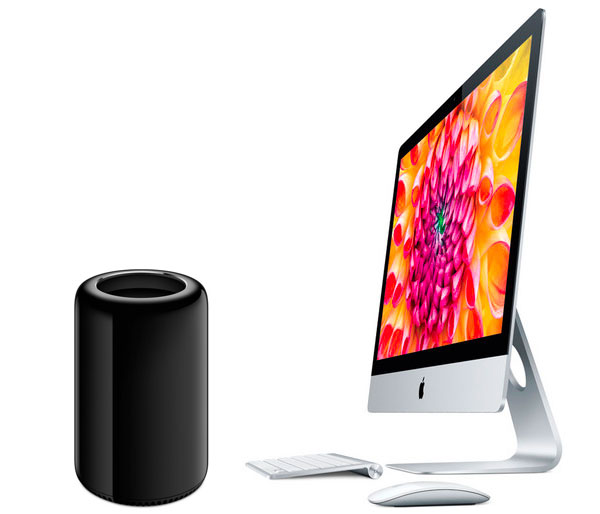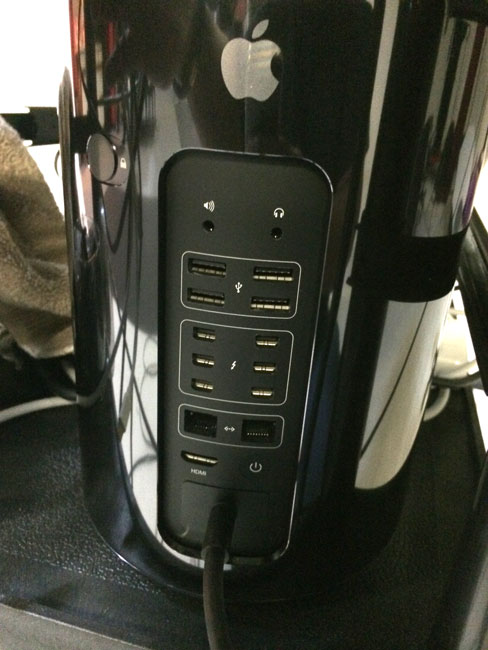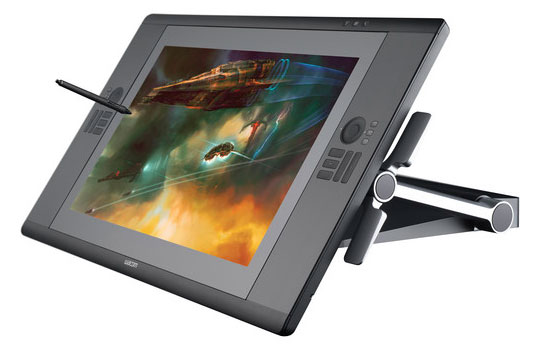
Rather than just do a review of the new Mac Pro and tell you how fast it is vs. any other Mac that Apple has made, I decided to approach this review from a different angle. There was a time when I bought Mac Pro towers because I wanted the fastest Mac available. However, I soon realized that as much as I didn’t want to admit it, the Mac Pro is “overkill” for what I do on a day-to-day basis. Sure, faster is always nicer than slower when it comes to waiting for a process to complete, but honestly I’m rarely waiting for a process to complete these days. Sure, I render video on a weekly basis and it would always be nicer to have those videos render faster, but is the faster render worth the money for a Mac Pro? The answer will of course depend on how much you find yourself waiting on your computer and not being able to do anything else while you’re waiting.
Let’s get some ground rules out of the way first
If you don’t like Macs or don’t want a Mac for whatever your reasons are, you can pretty much stop here and find something else to do with your time. I find it entertaining when people feel compelled to tell you/me how much they don’t want the thing you’re reviewing or writing about because they use something else. This is not a Mac vs. _______ post. If you’re happy with a Windows PC or Linux, or anything else, I’m happy for you. If you’re reading the rest of this post then I’ll assume that you’re a Mac user or thinking of becoming one.
The next thing I’d like to get out of the way is that if you’re looking for a Mac Pro review that tells you this new Mac Pro is better than the previous Mac Pro with all the benchmarks to back it up, then you’d probably be better served by other reviewers who have targeted the performance of the new model vs. the older model. I’m doing this review/comparison simply to answer the question, “as a photographer would I be better off spending my money on an iMac/MacBook Pro or a Mac Pro?” If you’re a videographer and you’re a Mac user then you probably already have the new Mac Pro because you demanded the fastest Mac you could get to render your videos.
Introduction
When I saw the rumors that Apple was going to release a radically different design for the Mac Pro, to be quite honest I was only mildly interested. As I stated above, I realized with my last Mac Pro that I wasn’t really a Mac Pro customer. Sure I appreciate the faster performance, but I found myself only using my Mac Pro when I knew a process was going to take a long time to complete. Otherwise I was quite happy just using my MacBook Pro simply because I could use it in any room at any time. I could take it with me on the road. However, I said to myself perhaps if the performance (for what I do) is significantly better and the price point for an entry model was $2,500 or less, I’d consider getting one. Well we know the latter didn’t happen, so now it was time to test the performance. I got the opportunity to test a Mac Pro standard configuration in my studio for a few weeks. I loaded the latest version of my Adobe Creative Cloud applications on it as well as a few utilities that I use such as ScreenFlow. Next, I began running side-by-side tests of the things that I do daily that take more than a few seconds. My assumption was that the Mac Pro would certainly be at least twice as fast at everything I threw at it than my 2012 MacBook Pro Retina Display Mac. Actually I was wrong!

When will a Mac Pro significantly outperform any other Mac?
As I said above, I was wrong in my assumption that the Mac Pro would be at least twice as fast at everything. Actually it is faster at everything! Just not by a margin of two. On every test I threw at it the Mac Pro outperformed my now two-year-old MacBook Pro, but in some cases it was only slightly faster. This is when I realized that in order to see significant speed improvements the software you’re testing not only needs to be optimized for the faster processors, but also it would need to take advantage of the multiple cores. Even then, the MacBook Pro is no slouch. It’s got multiple cores too. Where I saw the biggest differences was in (no surprise) video rendering and processes that take longer than a minute or so anyway.
What I do as a photographer
As a photographer I spend most of my time in Adobe Lightroom 5 and Adobe Photoshop CC. Photoshop CC definitely takes advantage of multiple cores and now has Open CL support. So filters will run faster on the new Mac Pro. All of these applications are 64bit native and that means that they’ll take advantage of additional RAM.
My first test was one of the things I do after every shoot. I convert my RAW files into .DNG (Digital Negative) format. This is one of the few times that I see a progress bar in Lightroom because it does take time to do it. I converted 435 16MP Nikon .NEF RAW files into DNG format.
First on the MacBook Pro it took 14 minutes 35 seconds
On the Mac Pro the same conversion took 12 minutes 12 seconds.
Yes it was faster! However, it was only about 2 minutes faster. I must say that I was a little disappointed. However, I moved on to the next test.
The next test was using the Web module in Lightroom to export a web gallery using the Client Response Gallery Template from The Turning Gate.

On the MacBook Pro this export took 7 minutes 41 seconds

On the NEW Mac Pro it took 4 minutes 9 seconds.
Ahhhh, much better. Almost half the time.
The next test was a simple HDR (High Dynamic Range) conversion in Photoshop CC using three RAW files. This is a two-part process. The first part is simply combining the three (or more) images together and aligning them. Then the second part of the process is applying whatever settings you want to control how your HDR looks.
The first part on the MacBook Pro took 12.70 seconds and on the Mac Pro it took 9.10 seconds
The second part on the MacBook Pro took 13.00 seconds and on the Mac Pro it took 11.13 seconds.
The next test was stitching a Panorama together using Photoshop CC and 10 RAW files
On the MacBook Pro this process took 1 minute 12 seconds
On the Mac Pro this process took 51 seconds.
I could have gone on running other tests and other filters, but these are the things I do on a regular basis. If it was faster at something that I rarely do, then I really don’t care as much. As you can see from the results above, the Mac Pro wins on every test as you would expect it to, but the results (even if it was twice as fast in every case) may not justify the difference in cost. We’ll get to that at the end.
Next it was time to look at what I do as a Photographer when it comes to video
I use video in a couple of different ways. The first as a photographer is to tell my story. This means capturing video with my DLSR, GoPro, iPhone, etc. I use Adobe Premiere Pro CC to assemble those videos and then output them to share (usually on YouTube). The next way that I use video and probably the way that I use video the most often is to record my Creative Cloud TV video podcasts. These screen recordings are done with ScreenFlow and since the editing I do is pretty simple I can edit these right in ScreenFlow. Of course I need to export those videos out and this can take a while depending on the length of the video. I had no doubts that this is where the Mac Pro would really shine. After all these are the kind of processor and resource intensive tasks that the Mac Pro was built for. I was not disappointed.
The first test I ran was an export of an hour-long edited video out of ScreenFlow.
On the MacBook Pro this export took 60 minutes
On the Mac Pro this export took 33 minutes.
It gets better in Adobe Premiere Pro CC and the Adobe Media Encoder CC. I needed to convert this video into a different format using the Adobe Media Encoder CC.
![]()
On the MacBook Pro this conversion/export took 34 minutes 36 seconds
![]()
On the Mac Pro this conversion/export took only 12 minutes 36 seconds
The Bottom Line
The NEW Mac Pro is the fastest Mac that Apple has ever created. The question you have to ask yourself is, “Is the speed difference worth the difference in price?” For me the answer is no. Sure if I spent my days rendering video all day every day, I’d already have the Mac Pro. There would be no question. However, as a photographer I can’t justify the difference in price. Hey! Wait a minute, you said in the title of this post “iMac or Mac Pro?”, yet all you’ve talked about is the MacBook Pro vs. the Mac Pro. This is true. I didn’t have a new iMac to compare it with. However, if you’re looking for a “desktop” Mac as a photographer, I’d seriously consider the current iMac. The current iMac will be as fast or faster than my 2012 MacBook Pro in every case. So here are some prices and specs to look at:
The Mac Pro model and configuration that I tested above is here. (Now keep in mind that if I was going to buy one I’d start with this configuration and I’d go with a bigger internal drive and more RAM)
The base configuration 4th gen 21.5″ iMac is here. However, this model is not a fair comparison. It’s probably a little slower than my MacBook Pro as it has a slower processor, less RAM, and no Flash Drive.
This would be the configuration that I would recommend and would be more of a fair comparison: 27″ iMac here.
If you’re interested in a similar configuration (using the current model) to my MacBook Pro 15″ Retina, it would be this one.
Why an iMac? Although I don’t use one, an iMac makes sense because you’re getting a fast Mac with a nice big 27″ display all in one.

Why a MacBook Pro? For me the MacBook Pro makes the most sense because when I’m at my desk I have connected to a nice 24″ HD Wacom Cintiq display/tablet. When i get ready to go I disconnect it and go. I have a computer with a nice 15″ Retina display when I’m on the road. If I didn’t travel for a living then I’d probably have an iMac. Since I travel a lot, a MacBook Pro makes more sense.
If you want the fastest Mac and you don’t mind spending $3,000-$4,000 (or more) on it, then definitely go with a Mac Pro. Everything you do will likely be faster than the Mac you’re currently using. Keep in mind that you’ll also need to buy a display, keyboard and mouse/tablet to go with it. At the end of the day I realize that computers have become “fast enough” and that I don’t spend a lot of time waiting these days. Even when a process such as a video render/export is going to take a few minutes I can toss it to the background and work on other things in the foreground. My last Mac Pro once configured set me back over $5,000 and while it was a beast, I found that I wasn’t really using it as much as I had hoped I would, so I sold it. The new Mac Pro is faster, but is it $4,000 faster? For me it’s not.




Hey Terry, Whats the tech specs of your Mac Book? By the way love your YouTube tutorials.
Cheers Mike
Here they are: http://www.bhphotovideo.com/c/product/872003-REG/Apple_Z9764_15_4_MacBook_Pro_Notebook.html/BI/2167/KBID/2909
Hi Terry, Thanks for this article. I’m a graphic designer, and now looking to replace the current desktop Mac. I got to say, I have been seduced by the new Mac Pro, but looking at the cost v speed, it would be crazy to go for the Mac Pro for my needs. Although from time to time, I do a bit of video work, it’s not enough to justify the Mac Pro. What you have written here has really help seal the deal for me and thank you for the spec on the iMac. Many thanks for the InDesign/Illustrator/Photoshop videos you do too, been very helpful over the years! Keep up the great work. All the best, Gina
Hey Terry — good and useful comparison; thanks!
I was forced to wrestle with this before the new Mac Pro came out, ordering one when it was released. My old Mac Pro (early 2008) died in the fall and was to cost more in repairs than I wanted to invest. I did a cost comparison for a new Mac Pro versus an iMac for the obvious reasons. Problem is, I didn’t value the very nice display on the iMac since I color correct my LaCie monitor and have two other monitors as well for a triple display set up. Since I had to move to external storage options anyway, I chose to invest in the new Mac Pro and with my business discount at Apple, I only paid a few hundred more for the Mac Pro. I use a MacBook Pro daily in my mobile use but value a desktop set up in the studio.
I have not been disappointed. For my situation it was the proper business decision as I looked at ROI. Other’s mileage may vary.
Cheers, Robert
I never went to the Mac Pro, mostly for the same reasons that you’ve shown here. The value proposition isn’t there for the type of work that I do.
The biggest problem I had with the old iMacs were external storage. Before Thunderbolt, you had either FireWire or USB 2.0. Neither was really fast enough for me, so I added an eSATA port from OWC.
Now that there are some decent Thunderbolt enclosure options, I’m happy with my iMac’s storage expansion options. As you said, the monitor is nice and I don’t feel the need for a faster graphics card. It holds enough RAM now, too.
Maybe I’d change my mind if I did a lot of video, but my iMac is a great value for my photography along with some Thunderbolt storage.
This is great and exactly what I was looking for. I’ve been shooting more and more video and was contemplating if I should get the Mac Pro but was overwhelmed by the price. That new Mac Pro is enticing but your performance comparison makes me think twice about it.
Do you know of any recent articles that do include a similar performance review for the iMac?
Thanks,
KJM
I went to a Mac Pro about 18 months ago when I needed to upgrade from a 4-year-old PC. Couldn’t wait for the then-rumored new Mac Pro. I use mine mainly for photo editing and a little video, so it seemed worth it vs. a MacBook Pro, especially since I could max it out with 32 gig of RAM, and I have 4 internal hard drive bays, two which are in use. Also, I could write it off as a business expense and finance it interest free with Apple’s Barclaycard VISA affiliation, so it didn’t take a big bite out at once.
It definitely speeded up my workflow vs. a PC so it was more than worth it for me on a couple of fronts.
Thanks for article. Good to know how it stacks up against a MacBook Pro in any case.
Could one survive and in fact flourish using only a new MacBook Pro (the one you speced out in the article)? I currently have a huge 5 year old PC and I have been wanting to switch to a Mac for a while now. Replacement time is here. The simplicity and minimalism of a powerful MacBook Pro is very appealing. I just have no experience with using a laptop. It’s either an iMac or a MacBook Pro for me. Keep in mind the most power hungry software I would be using is Lightroom 5.3 and Photoshop CC. In fact the Mac I get will have one main purpose, Lightroom and Photoshop use. Any thoughts?
Tom, seeing how I only use a MacBook Pro (and a personal MacBook Air) I would say the answer is yes. Like I said above I haven’t used a Mac Pro in a while now and I prefer the MacBook Pro over the iMac because I travel.
Very grateful for the quick response. The MacBook Pro is so appealing to me on so many levels. Many thanks for such a fine article on a subject that I am contemplating right now.
I know you said not to mention PC, but I have a hard time spending 70% more for a Mac when Apple sticks in 2 year old video cards compared to the latest PCs. Delete my post if you want, but that’s the hard truth.
I won’t delete your post, but I’m still trying to understand your “need” to post it. Clearly you want to use/buy something else. So why does it matter to you what others want/use? There are lots of things that I DON’T use and nor do I have the time to run around on the internet announcing it on reviews of those products. It’s OK that you use a PC.
What CPU did you use with this rig?
I’m curious about another facet of the speed debate I almost never see mentioned: multitasking.
As you note, the speed increase is often in the big chores, like conversion of files, rendering, etc. All unattended actions. In fact, much of that would be done at the tail of a workflow where I’d get up for a break anyway. Conversion of files might be at the beginning of a flow (say converting to a format you’d want to edit), but I imagine your workflow might get around this naturally by only converting what you need to work on that instant. So right away we notice that we perhaps only care about speed delays that inhibit what we’re working on right now, like waiting for a an image to refresh after applying a filter. Did you notice a big difference there?
And back to multitasking: if either machine was chugging away at a Big Chore like conversion or exporting, did you notice a slowdown in your work as you went back to Photoshop or even email or web browsing? I wouldn’t care if the MBP was slower if I can continue to work effectively while the machine is chugging away on something else.
Excellent article Terry. Why do you convert your RAW files to DNG files after a photo shoot? Do you have a previous blog post that explains your reasoning for doing the conversion to DNG?
I have several reasons and the idea of turning that into a blog post is great! Thanks for the idea and I’ll do it soon. Stay tuned.
Just my 2 cents. I have a three year old iMac, and noticed that it was struggling with large files during my photo editing. Using mostly LR, PS, with Topaz and Nik products. Really running into problems when combining large files ala HDR or 15 shots into a large pano. So, I just bought a screaming Mac Pro, and the results are…. disappointing to say the least. Programs like Denoise and Silver Efex Pro 2 are noticeably SLOWER on my Mac Pro. I feel gypped, and will probably return my Mac Pro to the Apple store on Monday.
Out of curiosity what version of PS are you running? Only reason I ask is that if it’s and older version with older plug-ins then they simply may not be optimized or 64 bit to take advantage of your new hardware. If they are all current the I’m not sure why they would run “slower”.
I am now using the latest version of PS CC, and they are up to date. I even ran a side by side test with everything equal from the get go. With the Denoise, I started with the same grainy photo, and the iMac took 8 seconds to “denoise” the photo and kick me back to PS, while the Mac Pro took 17 seconds. When you shell out 4K for a new machine, there is a certain expectation that it will outperform my three year old less-powerful machine…
Excellent article mate. I really enjoyed your comparisons and easy use of language. Thanks for clarifying things. Much Appreciated.
Thanks Terry, I really appreciate the ‘Mac users only’ qualifier.
I’m glad I’m not the only one tired of the trolls!